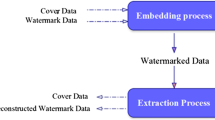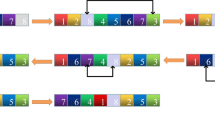Abstract
Vector geographic data are the fundamental achievements of national information infrastructure, and they play an important role in society’s development. How to protect the copyright of vector geographic data has become a popular issue in the age of big data, and digital watermarking technology can be used to solve this problem. In this paper, a robust and blind watermarking algorithm for vector geographic data is proposed based on the technology of coordinate mapping and matching detection. First, the basic principle for resisting data translation based on quantization index modulation (QIM) and matching detection was analyzed. Second, a watermarking algorithm for vector geographic data was designed based on coordinate mapping, QIM and matching detection. Finally, we performed experiments to test the robustness and adaptability of the proposed algorithm. The experimental results show that the proposed watermarking algorithm is not only robust against the watermarking attacks of data compression, data adding, data deleting, data cropping, feature deleting and data translation but also against composite attack. The proposed algorithm is also suitable for small vector geographic datasets such as point-based data.










Similar content being viewed by others
References
Abubahia A, Cocea M (2015) A clustering approach for protecting GIS vector data. In: Zdravkovic J, Kirikova M, Johannesson P (eds) Advanced information systems engineering: 27th international conference, CAiSE 2015, Stockholm, Sweden, June 8–12, 2015, Proceedings. Springer International Publishing, Cham, pp 133–147. doi:10.1007/978-3-319-19069-3_9
Benoraira A, Benmahammed K, Boucenna N (2015) Blind image watermarking technique based on differential embedding in DWT and DCT domains. EURASIP Journal on Advances in Signal Processing 2015(1):55. https://doi.org/10.1186/s13634-015-0239-5
Cao XC, Du L, Wei XX, Meng D, Guo XF (2016) High capacity reversible data hiding in encrypted images by patch-level sparse representation. IEEE Transactions on Cybernetics 46(5):1132–1143. https://doi.org/10.1109/TCYB.2015.2423678
Chen B, Wornell GW (2001) Quantization index modulation: a class of provably good methods for digital watermarking and information embedding. IEEE Trans Inf Theory 47(4):1423–1442. https://doi.org/10.1109/18.923725
Cox IJ, Miller ML, Bloom JA (2002) Digital Watermarking. Morgan Kaufmann, San Diego
Douglas DH, Peucker TK (1973) Algorithms for the reduction of the number of points required to represent a digitized line or its caricature. Cartographica: The International Journal for Geographic Information and Geovisualization 10(2):112–122. https://doi.org/10.3138/fm57-6770-u75u-7727
Guo YF, Au OC, Wang R, Fang L, Cao XC (2018) Halftone image watermarking by content aware double-sided embedding error diffusion. IEEE Trans Image Process 27(7):3387–3402. https://doi.org/10.1109/TIP.2018.2815181
Hwan Il K, Kab Il K, Jong Uk C (2002) A vector watermarking using the generalized square mask. In Proceedings of the International Conference on Information Technology: Coding and Computing, pp 234–236
Kim J, Won S, Zeng W, Park S (2011) Copyright protection of vector map using digital watermarking in the spatial domain. In proceedings of the 7th international conference on digital content, multimedia technology and its applications, Busan, Korea, 16-18 august, 2011, IEEE: New York, USA, 2011, pp. 154-159
Lee SH, Kwon KR (2013) Vector watermarking scheme for GIS vector map management. Multimed Tools Appl 63(3):757–790. https://doi.org/10.1007/s11042-011-0894-y
Li YY, Xu LP (2003) A blind watermarking of vector graphics images. In: proceedings of the 5th international conference on computational intelligence and multimedia applications, pp 424-429
Li Q, Min LQ, He ZH, Yang YQ (2011) A solution research on multiple watermark embedding. Science of surveying and mapping 36:119–120. https://doi.org/10.16251/j.cnki.1009-2307.2011.02.022
Neyman SN, Pradnyana INP, Sitohang B (2014) A new copyright protection for vector map using FFT-based watermarking. Telecommunication computing electronics and control 12:367-378. Doi:https://doi.org/10.12928/TELKOMNIKA.v12i2.1975
Niu XM, Shao CY, Wang XT (2006) A survey of digital vector map watermarking. International Journal of Innovative Computing Information and Control 2(6):1301–1316
Niu Y, Du JY, Li LL (2010) Digital watermarking system design and implementation based on LSB algorithm. Key Eng Mater 439-440:652–657. https://doi.org/10.4028/www.scientific.net/KEM.439-440.652
Ohbuchi R, Ueda H, Endoh S (2002) Robust watermarking of vector digital maps. In: proceedings of 2002 IEEE international conference on multimedia and expo, pp 577-580
Peng Z, Yue M, Wu X, Peng Y (2015) Blind watermarking scheme for polylines in vector geo-spatial data. Multimed Tools Appl 74(24):11721–11739. https://doi.org/10.1007/s11042-014-2259-9
Shao CY, Wang HL, Niu XM, Wang XT (2006) A shape-preserving method for watermarking 2d vector maps based on statistic detection. IEICE - Transactions on Information and Systems E89-D:1290–1293. https://doi.org/10.1093/ietisy/e89-d.3.1290
Solachidis V, Nikolaidis N, Pitas I (2000) Watermarking polygonal lines using Fourier descriptors. In: 2000 IEEE international conference on acoustics, speech, and signal processing, pp 1955-1958
Van BN, Lee SH, Kwon KR (2017) Selective encryption algorithm using hybrid transform for GIS vector map. J Inf Process Syst 13(1):68–82. https://doi.org/10.3745/jips.03.0059
Voigt M, Busch C (2002) Watermarking 2D-vector data for geographical information systems. In: Proceedings of the International Society for Optical Engineering, San Jose, CA, January 19, 2002, pp 621–628
Voigt M, Yang B, Busch C (2004) Reversible watermarking of 2D-vector data. In: Proceedings of the Multimedia and Security Workshop 2004, pp 160–165
Wang YF, Zhao J, Cui WH, Lv S (2012) A vector data watermarking algorithm based on minimum quad tree division. Comput Eng 38:111–113
Wang C, Peng Z, Peng Y, Yu L, Wang J, Zhao Q (2012) Watermarking geographical data on spatial topological relations. Multimed Tools Appl 57(1):67–89. https://doi.org/10.1007/s11042-010-0536-9
Yan HW, Zhang LM, Yang W (2017) A normalization-based watermarking scheme for 2D vector map data. Earth Sci Inf 10(5):1–11. https://doi.org/10.1007/s12145-017-0310-x
Yang CS, Zhu CQ (2011) Robust watermarking algorithm for geometrical transform for vector geo-spatial data based on invariant function. Acta Geodaetica Et Cartographica Sinica 40:256–261. https://doi.org/10.13203/j.whugis2011.12.012
Yang CS, Zhu CQ, Wang YY (2011) Self-detection watermarking algorithm and its application to vector geo-spatial data. Geomatics and information science of Wuhan University 36:1402–1405. doi:https://doi.org/10.13203/j.whugis2011.12.012
Zhang LM, Yan HW, Qi JX, Zhang YZ (2016) Multiple blind watermarking algorithm based on spatial-frequency domain for vector map data. Journal of Geomatics 41:32–36. https://doi.org/10.14188/j.2095-6045.2016.05.008
Zhou X, Ren Y, Pan X (2006) Watermark embedded in polygonal line for copyright protection of contour map. International Journal of Computer Science and Network Security 6:202–205
Acknowledgements
The work was supported by the National Natural Science Foundation of China (grant No. 41401518 and No. 41801303), the Natural Science Foundation of Jiangsu Province (grant No. BK20140066 and No. BK20170116).
Author information
Authors and Affiliations
Contributions
Chengsong Yang has worked to develop this paper. Changqing Zhu and Yingying Wang designed experiments. Ting Rui and Jingwei Zhu analyzed experimental results. Changqing Zhu, Yingying Wang and Kaimeng Ding reviewed the manuscript. All authors have read and approved the final manuscript.
Corresponding authors
Ethics declarations
Conflict of interest
The authors declare no conflict of interest.
Additional information
Publisher’s note
Springer Nature remains neutral with regard to jurisdictional claims in published maps and institutional affiliations.
Rights and permissions
About this article
Cite this article
Yang, C., Zhu, C., Wang, Y. et al. A Robust Watermarking Algorithm for Vector Geographic Data Based on Qim and Matching Detection. Multimed Tools Appl 79, 30709–30733 (2020). https://doi.org/10.1007/s11042-020-08916-4
Received:
Revised:
Accepted:
Published:
Issue Date:
DOI: https://doi.org/10.1007/s11042-020-08916-4




